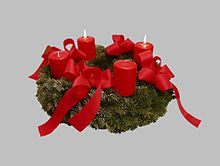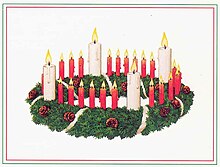Advent wreath
This article needs additional citations for verification. (December 2008) |




The Advent wreath, or Advent crown, is a Christian tradition that symbolizes the passage of the four weeks of Advent in the liturgical calendar of the Western church. It is usually a horizontal evergreen wreath with four candles. Beginning with the First Sunday of Advent, the lighting of a candle can be accompanied by a Bible reading and prayers. An additional candle is lit during each subsequent week until, by the last Sunday before Christmas, all four candles are lit. Some Advent wreaths include a fifth, "Christ" candle which can be lit at Christmas. The custom is observed both in family settings and at public church services.
History
The ring or wheel of the Advent wreath of evergreens decorated with candles was a symbol in northern Europe long before the arrival of Christianity. The circle symbolized the eternal cycle of the seasons while the evergreens and lighted candles signified the persistence of life in the midst of winter. Some sources suggest the wreath--now reinterpreted as a Christian symbol--was in common use in the Middle Ages, others that it was established in Germany as a Christian custom only in the 16th century, and others that the Advent wreath was not invented until the 19th century. This last theory credits Johann Hinrich Wichern (1808-1881), a Protestant pastor in Germany and a pioneer in urban mission work among the poor, as the inventor of the modern Advent wreath. During Advent, children at a mission school founded by Wichern would ask daily if Christmas had arrived. In 1839, he built a large wooden ring (made out of an old cartwheel) with 19 small red and 4 large white candles. A small candle was lit successively every weekday during Advent. On Sundays, a large white candle was lit. The custom gained ground among Protestant churches in Germany and evolved into the smaller wreath with four or five candles known today. Roman Catholics in Germany began to adopt the custom in the 1920s, and in the 1930s it spread to North America[1]. In Medieval times advent was a fast during which people's thoughts were directed to the expected second coming of Christ; but in modern times it has been seen as the lead up to Christmas, and in that context Advent Wreath serves as a reminder of the approach of the feast.
More recently, some Eastern Orthodox families have adopted an Advent wreath with six candles symbolizing the longer Advent season in Orthodox tradition.[2]
Forms of the Advent wreath
In Catholic churches , the most popular colours for the Advent candles are purple and rose. In the Western church, purple is the historic liturgical color for three of the four Sundays of Advent: once the color associated with royalty, it symbolizes Christ as the "Prince of Peace." Rose is the color for the Third Sunday of Advent, known as Gaudete Sunday from the Latin word "rejoice." Gaudete Sunday anticipates the joy of the Christmas celebration, so its color is a mixture of Advent purple and Christmas white. It may also symbolize the color of early dawn. In Protestant churches, it is more usual to use four red candles (reflecting their traditional use in Christmas decorations) because rose vestments and decorations are not commonly used in Protestant churches. Blue is also a popular alternative color both for Advent vestments and the Advent candles, especially in some Anglican and Lutheran churches. This is following with the liturgical seasons, blue meaning hope and waiting. Which aligns with seasonal meaning of advent.
Other variations of the Advent wreath add a white candle in the center to symbolize Christmas, sometimes known as the "Christ candle." It can be lit on Christmas Eve or Christmas Day. White is the traditional festal color in the Western church. Four red candles with one white one is probably the most common arrangement in Protestant churches in Britain.
Symbolism
There are several interpretations of the symbolism of the Advent wreath. Advent is four weeks The accumulation of light is an expression of the growing anticipation of the birth of Jesus Christ, who in Christian faith is seen as the light of the world. The circular wreath represents God's eternity and unity. Evergreens are a symbol of enduring life.
In some traditions the first candle is called the prophet's candle and is meant to signify the hope of Jesus' coming. The second is called the Bethlehem candle in honor of the city of Christ's birth. The third candle is the shepherds' candle. The final candle is the angels' candle, symbolising the angelic proclamation of joy at Christ's birth. A number of carols have been written for use with the short liturgy accompanying the lighting of the Advent candles in church services. A common format is to add an extra verse each week, relating to the symbolism of that week's candle.
In the Church of England's modern liturgy [3], the first candle is attributed to the Patriarchs, the second to the Prophets, the third to John the Baptist and the fourth to the Virgin Mary.
References
External links
- History of Advent wreath, sample lighting service, virtual wreath at i.UCC online community
- Advent FAQ at the Missouri Synod Lutheran web site
- Advent wreath FAQ at the Evangelical Lutheran Church in America web site
- Advent hymns including two examples of Advent Wreath carols
